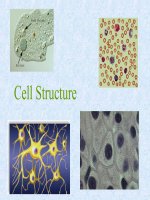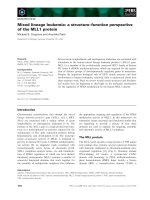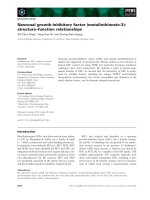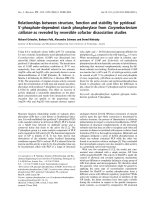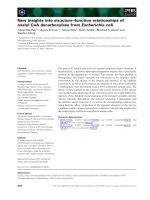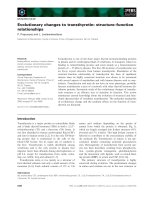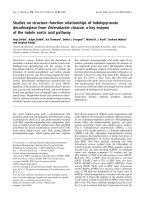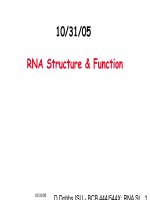Eukaryotic cell structure function lecture
Bạn đang xem bản rút gọn của tài liệu. Xem và tải ngay bản đầy đủ của tài liệu tại đây (1.84 MB, 32 trang )
About Science Prof Online
PowerPoint Resources
• Science Prof Online (SPO) is a free science education website that provides fully-developed Virtual Science Classrooms,
science-related PowerPoints, articles and images. The site is designed to be a helpful resource for students, educators, and
anyone interested in learning about science.
• The SPO Virtual Classrooms offer many educational resources, including practice test questions, review questions, lecture
PowerPoints, video tutorials, sample assignments and course syllabi. New materials are continually being developed, so check
back frequently, or follow us on Facebook (Science Prof Online) or Twitter (ScienceProfSPO) for updates.
• Many SPO PowerPoints are available in a variety of formats, such as fully editable PowerPoint files, as well as uneditable
versions in smaller file sizes, such as PowerPoint Shows and Portable Document Format (.pdf), for ease of printing.
• Images used on this resource, and on the SPO website are, wherever possible, credited and linked to their source. Any
words underlined and appearing in blue are links that can be clicked on for more information. PowerPoints must be viewed in
slide show mode
to use the hyperlinks directly.
• Several helpful links to fun and interactive learning tools are included throughout the PPT and on the Smart Links slide,
near the end of each presentation. You must be in
slide show mode
to utilize hyperlinks and animations.
•This digital resource is licensed under Creative Commons Attribution-ShareAlike 3.0:
Alicia Cepaitis, MS
Chief Creative Nerd
Science Prof Online
Online Education Resources, LLC
From the Virtual Cell Biology Classroom on ScienceProfOnline.com
Image: Compound microscope objectives, T. Port
Tami Port, MS
Creator of Science Prof Online
Chief Executive Nerd
Science Prof Online
Online Education Resources, LLC
Eukaryotic Cell
Structure &
Function
Images: Animal cell & Plant cell, M. Ruiz
From the Virtual Cell Biology Classroom on ScienceProfOnline.com
________________
•
Single-celled.
•
Reproduce by binary fission (another copy by dividing).
•
No cell nucleus or any other membrane-bound organelles.
DNA travels openly around the cell.
•
All bacteria are prokaryotes.
________________
•
Eu = “true”; karyon = “nucleus”
• Most organisms that we can see, such as trees, grass,
worms, flies, mice, humans, mushrooms and yeast are
eukaryotes.
•
Can either be single-celled or multi-celled.
• Can reproduce in one of several ways (Ex.
meiosis, mitosis).
•
Have cell nucleus within containing its DNA.
• Nucleus most evident distinction between these cell
types.
Images: Prokaryotic Cell, Eukaryotic cell , M. Ruiz
Q: What are the two basic types of cells?
From the Virtual Cell Biology Classroom on ScienceProfOnline.com
Image: Phylogenetic Tree, Eric Gaba, NASA Astrobiology Institute.
From the Virtual Cell Biology Classroom on ScienceProfOnline.com
Prokaryotes
Eukaryotes
Eukaryotic __________
• Like prokaryotes, and all living things,
genome is made of DNA.
• May include several to many linear
chromosomes within a membrane-bound
nucleus.
•
Q:
How many chromosomes do we have?
•
Replication (duplication of DNA prior to cell
division) occurs in all living things.
•
Two locations of eukaryotic DNA
– Nuclear DNA
–
Extranuclear DNA
Image: Spectral karyotype, Jane Ades, NHGRI
From the Virtual Cell Biology Classroom on ScienceProfOnline.com
CYTOPLASM
Nickname: The Matrix
Function: "molecular chowder"
in which the organelles are
suspended.
• Inside the plasma membrane, the nucleus
is surrounded by cytoplasm.
•
A water-like substance that fills cells.
• Consists of _________ and
__________ ________, except for the
cell nucleus.
•
Cytosol is made up of water, salts, organic
molecules and many enzymes that
catalyze reactions.
Q: Eukaryotes? Prokaryotes? Both?
Image: Eukaryotic Cell Diagram, M. Ruiz
From the Virtual Cell Biology Classroom on ScienceProfOnline.com
CYTOSKELETON
Nickname: Scaffolding & Highways
Functions: Multiple
•
Maintains cell _________.
•
Protects the cell.
•
Enables some cell ________ (using
structures such as flagella and cilia).
• Plays important roles in intra-cellular
transport
(the movement of vesicles and
organelles).
•
Plays important role in cellular
___________.
Q: Eukaryotes? Prokaryotes? Both?
Images: Fluoresced Eukaryotic Cell, NIH.
From the Virtual Cell Biology Classroom on ScienceProfOnline.com
CYTOSKELETON:
Microfilaments,
Intermediate Filaments
& Microtubules
Network of protein fibers running throughout the cytoplasm
that give a cell its shape & provide a basis for movement.
1. Micro__________
Two intertwined strands of actin protein.
2. ____________ Filaments
Fibrous proteins supercoiled into thick cables.
3. Micro____________
•
Hollow tubes of tubulin
•
Cell shape, cell movement, chromosome movement during division
•
“Highways” along which the organelles travel and are conveyed.
•
Microtubules may work alone, or join with other proteins to form more complex
structures called cilia, flagella or centrioles.
Image: Source Unknown
From the Virtual Cell Biology Classroom on ScienceProfOnline.com
CYTOSKELETON: Centrioles & Centrosomes
The ____________, also called the "microtubule organizing center", is an area
in the cell where microtubles are produced.
Within the cells of animals are a pair of ___________, made of nine sets of
triplet microtubules.
Microtubules > Centriole > Centrosome
Images: Centriole Cross-section & Centriole-3D, Twooars;
Micrograph of Centrioles, Christos Chinopoulos
From the Virtual Cell Biology Classroom on ScienceProfOnline.com
_______ & __________
• External appendages from
cell membrane.
• Aid in locomotion of the
cell or movement of
materials near cell.
• Motility > coordinated
sliding movements of
microtubules.
• Both
Prokaryotes & Eukaryot
es
can have external
appendages, but are
constructed
differently.
• Eukaryotes may have
flagella or cilia
(components of
cytoskeleton covered
with plasma membrane).
• Prokaryotes may have
flagella, endoflagella,
fimbiae or pili
(composed of
protenaceous molecules
and not covered with
plasma membrane).
Images: Cilia of the lung trachea epithilium, Charles Daghlian,
Cilum Diagram & Flagellum Diagram, M. Ruiz; Sperm & Egg, Wiki
From the Virtual Cell Biology Classroom on ScienceProfOnline.com
Ribosomes
Q: What do they do?
Q: What are they made of?
Can be found alone in the
cytoplasm, in groups called
polyribosomes, or attached to
the endoplasmic reticulum.
Q: Eukaryotes? Prokaryotes?
Both?
Images: Ribosome translating protein, animation,
Xvazquez; Ribosome Structure, Vossman
From the Virtual Cell Biology Classroom on ScienceProfOnline.com
Click here for
animation of
ribosome building a
protein.
Membrane-bound Organelles
Eukaryotic cells
have many
organelles.
Prokaryotes only
have ribosomes,
which are not bound
by a membrane.
Membrane-bound
eukaryotic organelles
organize functions
within the cell.
Image: Eukaryotic Cell Diagram, M. Ruiz
From the Virtual Cell Biology Classroom on ScienceProfOnline.com
System of internal membranes within eukaryotic cells that divide the cell into
compartments, or organelles.
Transport system, for moving molecules through interior of cell, as well as
interactive surfaces for lipid and protein synthesis.
Membranes of the endomembrane system are made of a lipid bilayer, with proteins.
The Endomembrane System
consists of:
1. ________
2. __________ ________
3. ______ _______
4. __________
5. __________
6. _________ ___________
Image: Endomembrane system diagram, M. Ruiz
From the Virtual Cell Biology Classroom on ScienceProfOnline.com
ENDOMEMBRANE SYSTEM ORGANELLES:
Nucleus
Nickname: Control Center
Function: Separates the
genetic material (DNA)
from the rest of the cell.
• DNA, the genetic
material, is a blueprint,
or code for making
proteins
.
• _________ _________
is the double membrane
structure that separates
nucleus from cytoplasm.
Images: Endomembrane system
diagram,& Nucleus diagram, M. Ruiz
From the Virtual Cell Biology Classroom on ScienceProfOnline.com
ENDOMEMBRANE SYSTEM ORGANELLES:
Endoplasmic Reticulum
Nickname:
Production Factory
(makes proteins and lipids)
Function: Internal
production & delivery
system of the cell.
•
System of membranous channels
and vesicles.
•
________
is studded with
ribosomes. Site of protein
synthesis and processing.
•
________
lacks ribosomes. Site
of synthesis of phospholipids and
packaging of proteins into
vesicles.
Images: Endomembrane system diagram, M.
Ruiz, ER photomicrograph, Louisa Howard.
From the Virtual Cell Biology Classroom on ScienceProfOnline.com
ENDOMEMBRANE SYSTEM ORGANELLES :
_________ ___________
Nickname:
Assembly Factory
Functions:
•
Takes simple molecules and puts
them together into more complex
macromolecules.
•
Packages, modifies, and
transports materials to different
location inside/outside of the cell.
Appearance: Stack of pancakes.
•
Consists of a stack of curved saccules.
•
Receives protein and also lipid-filled
vesicles from the ER, packages,
processes, and distributes them
within
the cell
or for
export out of the cell
(secretion)
.
•
Also encloses digestive enzymes into
membranes to form lysosomes.
Images: Endomembrane system diagram, M. Ruiz, Golgi
apparatus photomicrograph, Louisa Howard.
From the Virtual Cell Biology Classroom on ScienceProfOnline.com
ENDOMEMBRANE SYSTEM ORGANELLES:
_____________
Nickname: The Trucks
Function: Store,
transport, or digest
cellular products and
waste.
•
Small compartments separated from
the cytosol by at least one lipid
bilayer.
•
Made in Golgi apparatus, ER, or
from parts of the plasma membrane.
•
Vesicles form while taking in
(
____________
) or discharging
(
____________
) materials.
Image: Endomembrane system diagram, M. Ruiz
From the Virtual Cell Biology Classroom on ScienceProfOnline.com
ENDOMEMBRANE SYSTEM ORGANELLES:
_______________
Nickname: Recycling
Trucks
Function: Breaks down
food into particles and to
destroys old cellular
components.
•
Q: Which organelle produces
lysosomes?
•
Contain hydrolytic enzymes and
are involved in intracellular
digestion.
Images: Endomembrane system diagram, M. Ruiz,
Lysosome action diagram, Encyclopedia of Science
From the Virtual Cell Biology Classroom on ScienceProfOnline.com
ENDOMEMBRANE SYSTEM ORGANELLES:
____________ _____________
Image: Endomembrane system diagram, M.
Ruiz Cell Membrane diagram, Wiki
•
Q: What is it made of?
•
Q: What is its function?
From the Virtual Cell Biology Classroom on ScienceProfOnline.com
Let’s watch an
animation on
endocytosis & exoc
ytosis
!
Image: Endocytosis / Exocytosis, Nicolle Rager Fuller
Endomembrane System
From the Virtual Cell Biology Classroom on ScienceProfOnline.com
Endomembrane System
1. Nuclear envelope
2. Endoplasmic reticulum
3. Golgi apparatus
4. Vesicles
5. Lysozomes
6. Plasma Membrane
We hope that you enjoyed
your trip through the
endomembrane system!
Have a
nice day!
Image: Endomembrane system, M. Ruiz
From the Virtual Cell Biology Classroom on ScienceProfOnline.com
Organelles: Energy-Related
______________
&
______________
•
Both organelles house
energy in the form of ATP.
•
Both ancestrally were
independent cells that
formed a symbiotic
relationship with other
cells.
Found in
nearly all
eukaryotes
Found in
plants &
algae &
some
microbes
Images: Mitochondrion diagram
M. Ruiz; Chloroplast diagram, Wiki
From the Virtual Cell Biology Classroom on ScienceProfOnline.com
ENERGY-RELATED ORGANELLES:
Mitochondria
Nickname: The Powerhouse
Function: Energy formation
Breaks down food to make ATP
ATP is the major fuel for all cell
activities that require energy
•
Bound by a double membrane surrounding fluid-filled
matrix.
•
The inner membranes of mitochondria are
__________
.
•
The
__________
contains enzymes that break down
carbohydrates and the cristae house protein complexes
that produce ATP.
Images: Mitochondrion diagram M. Ruiz;
Mitochondria photomicrograph, Louisa Howard
From the Virtual Cell Biology Classroom on ScienceProfOnline.com
Now let’s learn
about
additional
structures
found in
PLANT Cells
•
Images: All images by T. Port
From the Virtual Cell Biology Classroom on ScienceProfOnline.com
ENERGY-RELATED ORGANELLES:
Chloroplasts
Nickname: Solar
Panels
Function: Captures
Sunlight Energy &
Makes ATP
___________ (a green
pigment) absorbs solar
energy and carbohydrates
are made in the stroma.
Images: Plant cells with chloroplasts, Kristian
Peters, Chloroplast diagram, Wiki
From the Virtual Cell Biology Classroom on ScienceProfOnline.com
